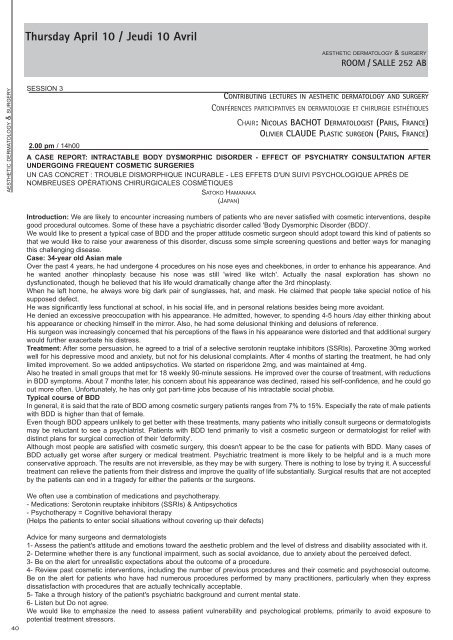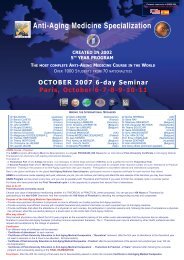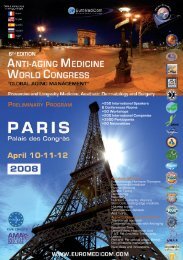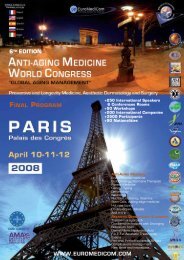FINAL PROGRAM 6TH EDITION - EuroMediCom
FINAL PROGRAM 6TH EDITION - EuroMediCom
FINAL PROGRAM 6TH EDITION - EuroMediCom
Create successful ePaper yourself
Turn your PDF publications into a flip-book with our unique Google optimized e-Paper software.
Thursday April 10 / Jeudi 10 AvrilAESTHETIC DERMATOLOGY & SURGERYROOM / SALLE 252 ABAESTHETIC DERMATOLOGY & SURGERYSESSION 3CONTRIBUTING LECTURES IN AESTHETIC DERMATOLOGY AND SURGERYCONFÉRENCES PARTICIPATIVES EN DERMATOLOGIE ET CHIRURGIE ESTHÉTIQUESCHAIR: NICOLAS BACHOT DERMATOLOGIST (PARIS, FRANCE)OLIVIER CLAUDE PLASTIC SURGEON (PARIS, FRANCE)2.00 pm / 14h00A CASE REPORT: INTRACTABLE BODY DYSMORPHIC DISORDER - EFFECT OF PSYCHIATRY CONSULTATION AFTERUNDERGOING FREQUENT COSMETIC SURGERIESUN CAS CONCRET : TROUBLE DISMORPHIQUE INCURABLE - LES EFFETS D'UN SUIVI PSYCHOLOGIQUE APRÈS DENOMBREUSES OPÉRATIONS CHIRURGICALES COSMÉTIQUESSATOKO HAMANAKA(JAPAN)Introduction: We are likely to encounter increasing numbers of patients who are never satisfied with cosmetic interventions, despitegood procedural outcomes. Some of these have a psychiatric disorder called 'Body Dysmorphic Disorder (BDD)'.We would like to present a typical case of BDD and the proper attitude cosmetic surgeon should adopt toward this kind of patients sothat we would like to raise your awareness of this disorder, discuss some simple screening questions and better ways for managingthis challenging disease.Case: 34-year old Asian maleOver the past 4 years, he had undergone 4 procedures on his nose eyes and cheekbones, in order to enhance his appearance. Andhe wanted another rhinoplasty because his nose was still 'wired like witch'. Actually the nasal exploration has shown nodysfunctionated, though he believed that his life would dramatically change after the 3rd rhinoplasty.When he left home, he always wore big dark pair of sunglasses, hat, and mask. He claimed that people take special notice of hissupposed defect.He was significantly less functional at school, in his social life, and in personal relations besides being more avoidant.He denied an excessive preoccupation with his appearance. He admitted, however, to spending 4-5 hours /day either thinking abouthis appearance or checking himself in the mirror. Also, he had some delusional thinking and delusions of reference.His surgeon was increasingly concerned that his perceptions of the flaws in his appearance were distorted and that additional surgerywould further exacerbate his distress.Treatment: After some persuasion, he agreed to a trial of a selective serotonin reuptake inhibitors (SSRIs). Paroxetine 30mg workedwell for his depressive mood and anxiety, but not for his delusional complaints. After 4 months of starting the treatment, he had onlylimited improvement. So we added antipsychotics. We started on risperidone 2mg, and was maintained at 4mg.Also he treated in small groups that met for 18 weekly 90-minute sessions. He improved over the course of treatment, with reductionsin BDD symptoms. About 7 months later, his concern about his appearance was declined, raised his self-confidence, and he could goout more often. Unfortunately, he has only got part-time jobs because of his intractable social phobia.Typical course of BDDIn general, it is said that the rate of BDD among cosmetic surgery patients ranges from 7% to 15%. Especially the rate of male patientswith BDD is higher than that of female.Even though BDD appears unlikely to get better with these treatments, many patients who initially consult surgeons or dermatologistsmay be reluctant to see a psychiatrist. Patients with BDD tend primarily to visit a cosmetic surgeon or dermatologist for relief withdistinct plans for surgical correction of their 'deformity'.Although most people are satisfied with cosmetic surgery, this doesn't appear to be the case for patients with BDD. Many cases ofBDD actually get worse after surgery or medical treatment. Psychiatric treatment is more likely to be helpful and is a much moreconservative approach. The results are not irreversible, as they may be with surgery. There is nothing to lose by trying it. A successfultreatment can relieve the patients from their distress and improve the quality of life substantially. Surgical results that are not acceptedby the patients can end in a tragedy for either the patients or the surgeons.We often use a combination of medications and psychotherapy.- Medications: Serotonin reuptake inhibitors (SSRIs) & Antipsychotics- Psychotherapy = Cognitive behavioral therapy(Helps the patients to enter social situations without covering up their defects)40Advice for many surgeons and dermatologists1- Assess the patient's attitude and emotions toward the aesthetic problem and the level of distress and disability associated with it.2- Determine whether there is any functional impairment, such as social avoidance, due to anxiety about the perceived defect.3- Be on the alert for unrealistic expectations about the outcome of a procedure.4- Review past cosmetic interventions, including the number of previous procedures and their cosmetic and psychosocial outcome.Be on the alert for patients who have had numerous procedures performed by many practitioners, particularly when they expressdissatisfaction with procedures that are actually technically acceptable.5- Take a through history of the patient's psychiatric background and current mental state.6- Listen but Do not agree.We would like to emphasize the need to assess patient vulnerability and psychological problems, primarily to avoid exposure topotential treatment stressors.
















